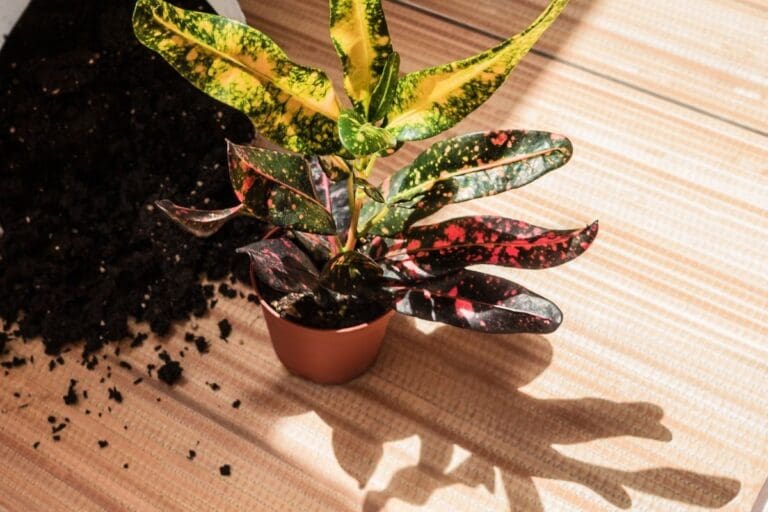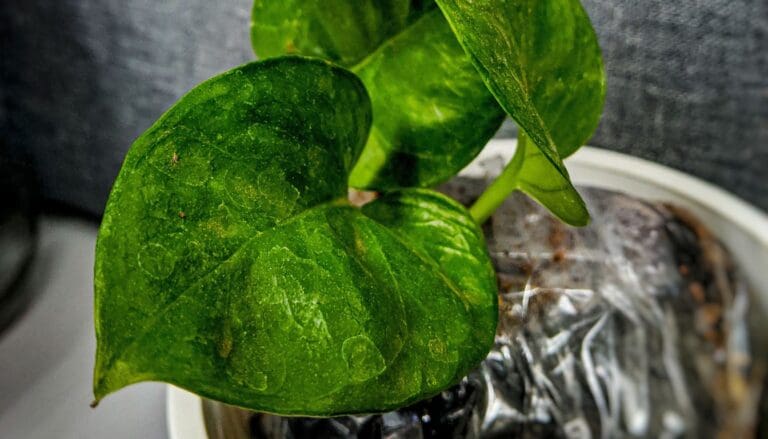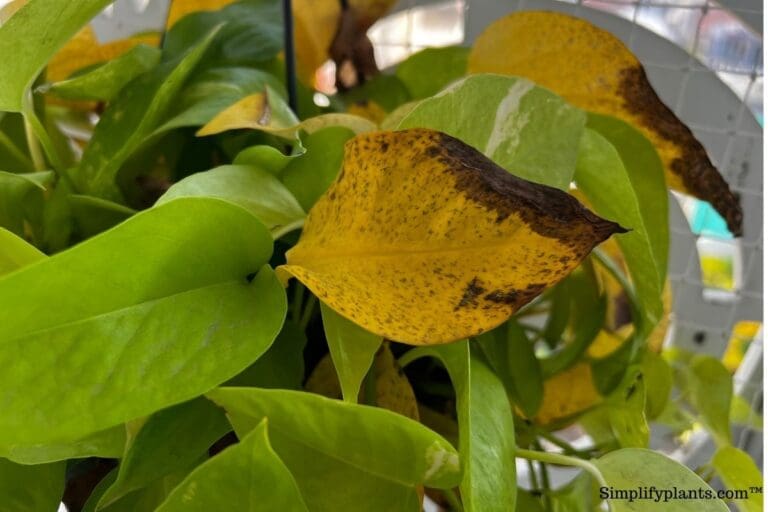Can Boston Fern Grow In Water? (+How To Grow & Care)
Boston ferns grow beautiful fronds when grown with proper care and techniques. They are easy to grow, and when planted in water, it increases their beauty even more. Let’s understand how Boston Ferns can grow in water.
Boston fern can be grown in water if you provide them with the right growing conditions. Growing fern in water is particularly easier than growing them in soil, but their growth rate can be slower than in soil. Provide the plant with adequate light and nutrients to keep it thriving.
In this article, I will elaborate on how you can grow Boston Fern in water and how you can take care of all its requirements.

Please note: Simplify Plants is reader-supported. Some links in the post are affiliate links and I get a commission from purchases made through links in the post.
Things to know before growing Boston Fern in water
You should know a few things before growing a Boston fern in water.
I have listed some points below:
- Boston fern fronds that don’t have roots attached will neither grow in water nor soil.
- To ensure successful growth, make sure the frond you choose has roots that can be emerged in a glass of water.
- The plant will thrive best when planted during spring.
- It will grow well when it receives soft bright morning sunlight and indirect light throughout the day.
- You should change the water at regular intervals to avoid bacterial growth and loss of nutrition.
How do you grow Boston Fern in water?
Boston fern is an easy plant to grow in water.
Still, there are certain rules you need to follow to make the process easy.
The technique used to grow ferns in water is known as the hydroculture technique.
Nowadays, gardeners are choosing hydroculture to grow Boston ferns because despite their hardy nature, sometimes they are tricky to care for.
Often, they demand constant moisture and high humidity levels to fulfill their needs, and if not fulfilled, they become thirsty.
The following steps will guide you to grow Boston fern in water.
1. Select a section of the plant properly

The section you choose to grow is important as it reflects how the plant will grow.
The frond you choose must have healthy growing roots.
Without the roots, growing Boston fern is impossible.
The fronds should also be strong and healthy themselves.
A frond is considered healthy when it contains healthy green leaves, is free from pests, and has slight root nodes at the bottom.
Always choose healthy mature fronds as they can only produce or grow new roots.
2. Pull out the sections or fronds from the Boston fern
Since a cutting without roots will not work, you can take the entire Boston fern out and divide it or you can pull out one or more fronds.
Make sure you do this carefully as you don’t want to harm the roots of the fronds.
If you are dividing the entire plant, you might need pruners or scissors to remove the tangled or damaged roots.
Always use sharp and sterilized pruners to avoid the chances of infections or diseases.
3. Wash the roots
Removing old potting soil from the roots is important.
It ensures that the plant is free from any bacteria or fungi, and also it doesn’t have any extra salt build-up from the previous soil.
Sometimes due to extra fertilization, unhealthy salt build-ups remain near the roots.
Washing those roots removes the extra salt and unhealthy soil to help the plant grow effectively.
Exposing the roots to water will also help sterilize and protect them from unwanted bacterial risks.
Prune off any rotten, rootbound, or damaged roots and detangle if the roots have formed clusters while growing in soil.
The section you chose is a part of that old plant, which needs an opportunity to start growing freshly in new, improved conditions.
4. Choose the correct container

One of the essential steps is to get a proper container.
We tend to grow plants in water just to witness the beautiful process of root growth.
Thus, glass containers are always perfect for any plants growing in water.
Transparent glass containers make it easy to inspect water too.
We can easily determine when to change water only by looking at its color.
Moreover, transparent glass containers can also be used as decorative centerpieces.
Gardeners use glass pots to decorate center tables, dinner tables, or any areas they wish to.
There is no restriction on using opaque pots for this purpose.
5. Filling water and other essentials into the container
Try to avoid tap water as they have high concentrations of chlorine, iron, and other unwanted minerals.
Sometimes they may have other harmful chemicals.
While filling the vase before planting the frond, consider using boiled or mineral-free water.
Add minerals and nutrients to the water as needed.
Then, fill the bottom of the vase with some stones or gravel brought from stores.
They can serve two purposes:
- These act as a decorative element. Or a simple, clear jar may look empty.
- The stones will help hold a single frond to the center of the jar rather than allowing it to drift.
Water is our only growing medium so choose wisely.
Poor water quality will make the plant weak and leggy and reduce its growth rate.
6. Place the frond in the container

Take a clear container, vase, or glass bowl and place the frond or section of the plant you choose in it.
A clear glass container is always recommended as you can experience the beautiful process of roots growing inside the water.
Otherwise, any container that can hold water and act as effective support throughout the growing phase can also be used.
Add some gravel and stones to the bottom of the container to fix its roots to the center.
This will also help the plant secure a place rather than moving and floating around the vase.
While filling the container, make sure that the water is non-chlorinated, but it can have some added nutrients and minerals to make it sufficient for the plant.
7. The finishing steps
After you have successfully planted the fern in water, secure it to the center of the vase with the help of gravel and stones.
You can also find a specific tool in many stores that helps hold plants steady from the rim of the vase to the water.
Then the only step remaining is to take proper care of the newly potted plant.
The best time to grow Boston Fern in water is summer and spring.
How to care for the Boston fern in water?
Few factors promote healthy growth in plants.
The first step is to provide the right environment for them.
Boston ferns require a cool place with indirect bright light and high humidity to flourish best.
They also show significant growth in moist soil, and since you are growing them in water, it has some additional benefits.
The basic requirements for Boston ferns while growing them is water, light, the nutritive value of the water, etc.
Let’s understand.
Light requirements

Boston ferns need bright indirect sunlight for at least 4-5 hours when growing indoors.
Too much exposure or direct sunlight can scorch their fronds.
The ideal temperature they need for growing is 60-75 degrees, but they can tolerate climatic temperatures as low as 55 degrees.
Late morning or afternoon sunlight during spring is ideal for Boston fern.
You can keep them outdoors in a shady spot if they are not receiving enough light indoors.
Every other species of Boston fern has different light requirements, and the light conditions may change when the sunlight is intense during summers.
If all the sides of the Boston fern don’t receive proper sunlight, rotate the plant every week.
Your house may lack a proper source of indirect bright light, and artificial light is a savior.
Also read: What Kind Of Lighting Does A Boston Fern Need?
Nutritive Value of the water
Sometimes growing plants in tap water can give poor results as they may have harmful, unwanted minerals.
Any water which has salt and sugar can hurt plants.
The best water to grow plants in it is rainwater.
Rainwater is considered the purest form of water as it barely has harmful elements which can potentially harm plants.
Many gardeners can use nutritional sticks, powders, or liquids to provide additional nutrients to the water.
These nutritional supplements are easily available in markets or nurseries.
Moreover, bottled or packaged drinking water is also considered while growing plants, but it sounds illogical.
But gardeners can use bottled water in the initial stage while filling up the container.
Change the water at regular intervals or whenever it gets dirty.
Generally, changing the water once every week is enough.
Use pesticides and fungicides if required

Pesticides and fungicides are important when growing Boston fern in water.
Water makes any plant prone to bacterial and fungal growth.
Thus, to get rid of them, pesticides are recommended.
Boston ferns are likely to be eaten by caterpillars leaving holes between the leaves, sometimes chewing them off completely.
The major pests that attack Boston ferns are caterpillars, mealybugs, false spider mites, and thrips.
Mealybugs and scales usually attack when pruners are not sterilized properly, or infested plants contact them.
Neem oil is the best organic way of eliminating these pesky pests.
However, you can opt for a pesticide if Neem oil fails to eradicate the bugs.
Fungal growth in roots is also common due to continuous stay in the water.
Chemical as well as organic fungicides are easily available in the market.
Also read: Boston Fern Pests And Diseases: Common Bugs & Diseases+How To Fix
Pruning
Consider pruning when the plant becomes leggy or bushy.
Other than that, it is not necessary.
Boston ferns are famous for their fronds, and when taken care of properly or shaped, they will flourish even more.
Prune during the active growing phase and always with a sterilized, clean and sharp pair of scissors.
Trim off to remove damaged leaves or unwanted growth.
Also read: Should I Trim My Boston Fern? (+How To Prune)
Repotting
When growing Boston fern in water, repotting is unnecessary but change the water when it becomes dirty.
By saying dirty, I mean when the water’s color changes.
Water quality largely affects plant growth and health.
Fertilization

You can add liquid fertilizers with a proper ratio and a little high Nitrogen concentration to the water.
Fertilizers help to increase water quality.
Nitrogen acts as a super element in fertilizers which helps in plant growth, but too much Nitrogen can burn the tips of leaves.
Epsom salt also has perfect minerals with the proper ratio for fern care and growth.
Compared to other foliage plants, Boston ferns are light feeders.
A liquid fertilizer of ratio 20:10:20 is enough for them.
Add a few drops of it to the water during spring and summer once a month.
Never add fertilizers during dormancy as they can dry the full plant and kill it.
Growing ferns in water is easy as long as you know the proper steps and take proper care after the process.
Also read: Should I Fertilize My Boston Fern? (Ideal Fertilizer+When & How Much)
Can Boston ferns live underwater?
Household gardeners can grow Boston fern in water but not completely submerged.
However, some species of ferns like maidenhair fern can significantly grow well underwater.
Boston ferns can grow well in water as long as they receive sufficient light with proper nutrients for growing.
Avoid shocking the plant.
Stress and shocks can reduce the growing rate of plants.
Boston fern will positively grow as long as the roots are submerged underwater and other parts are above water.
If kept underwater, your Boston fern will die due to a lack of oxygen, other essential elements from the air, and sunlight.
While growing them, one can also use a moss stick for support.
The new cuttings may need support while growing during the initial stage.
Reference: University of Florida, The University of Arkansas Division, Texas A&M University System, The University of Georgia, University of New Hampshire, Wikipedia, The Royal Horticultural Society.
Recommended Garden Supplies
| Product Image | Our Recommended Gardening Supplies | Check Offers! |
|---|---|---|
Top Top
Top
Top
Top
Top
Top
Top
Top | rePotme Houseplant and Tropical Classic Potting Soil Mix | Check Offer On Amazon |
 Top
Top
Top
Top
Top
Top
Top
Top | Espoma Organic Indoor Plant Food | Check Offer On Amazon |
 Top
Top
Top
Top
Top
Top
Top
Top | GooingTop LED Grow Light 6000K Full Spectrum Clip Plant Growing Lamp | Check Offer On Amazon |
 Top
Top
Top
Top
Top
Top
Top
Top | Soil Moisture Meter | Check Offer On Amazon |
 Top
Top
Top
Top
Top
Top
Top
Top | Govee Hygrometer Thermometer, Bluetooth Enabled! | Check Offer On Amazon |
 Top
Top | LEVOIT Humidifiers for Large Room(Best For Plants) | Check Offer On Amazon |
 Top
Top
Top
Top
Top
Top
Top
Top | Upgraded DIY Automatic Drip Irrigation Kit, 15 Potted Houseplants Support | Check Offer On Amazon |
 Top
Top
Top
Top
Top
Top
Top
Top | Stainless Steel Heavy Duty Gardening Tool Set | Check Offer On Amazon |
 Top
Top
Top
Top
Top
Top
Top
Top | Bonide Insecticidal Soap | Check Offer On Amazon |
 Top
Top
Top
Top
Top
Top
Top
Top | Bonide 32 oz Spray Neem Oil for Organic Gardening | Check Offer On Amazon |
 Top
Top
Top
Top
Top
Top
Top
Top | Garden Safe Fungicide | Check Offer On Amazon |






